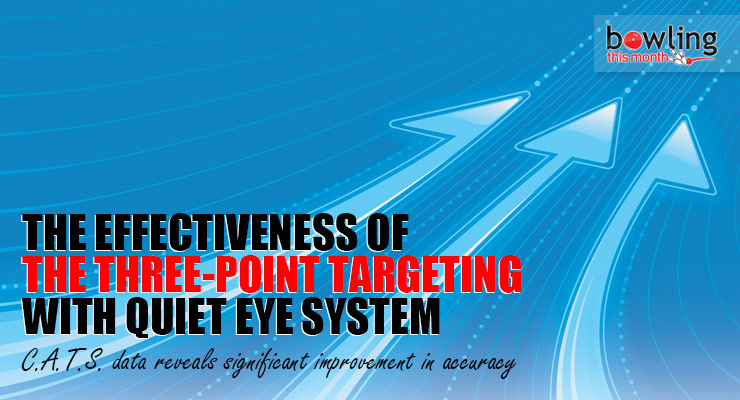This month, I want to review the effectiveness of the Three-Point Targeting with Quiet Eye System. Over the past 18 months, I have published this topic in separate installments. In July 2007, I first introduced BTM readers to the Three-Point Targeting System. And, in March of this year, I shared with BTM readers the importance of having a “quiet eye” in targeting. Yet, the three-point system continues to evolve, based on my experiences teaching this system, elite bowlers implementing it, modifying/adding to it over the last two years, and new findings and research. Over the last six months, I have merged the Quiet Eye process more effectively into Three-Point Targeting. And, this new evolution has shown incredible results. I eagerly share these findings with readers.
I will present data to show how much immediate improvement can occur when using the advanced targeting system. In addition, I present a review of the current system in its entirety in one location. With the use of C.A.T.S. as objective data, the Three-Point Targeting with Quiet Eye System is proving to be an extremely powerful system in improving accuracy for elite bowlers.
Determining effectiveness
When bowlers come to the Kegel Training Center for lessons, we always begin by taking an initial evaluation of every bowler using our Computer Aided Tracking System (C.A.T.S.). We are fortunate to have C.A.T.S. on every lane of the Training Center. With C.A.T.S., a coach can measure a bowler’s ability to repeat similar shots. After a bowler takes ten consecutive strike shots, C.A.T.S. measures consistency of ball speed, rev rate, target accuracy at the arrows, target accuracy at 39 feet, as well as launch angle and entry angle consistency. With the C.A.T.S. report, we can then compare the bowler to professionals in each of these performance categories. This becomes the baseline data set for a bowler’s accuracy, for comparison purposes.
After an initial C.A.T.S. assessment, I always teach clients the Three-Point Targeting with Quiet Eye System as a process to help them improve their target lines as well as something to take home on their DVD. This has proven to be a user-friendly advanced lane play system to aid them in lining up more accurately on any lane condition. This is done before any physical game changes are made. And, with C.A.T.S., I can measure the immediate improvement of a bowler’s ability to repeat shots, after learning this advanced targeting system. With access to C.A.T.S., it provides an opportunity to test the immediate effectiveness of this advanced targeting method that has ...
This article is only available to Bowling This Month subscribers. Click below to get instant access to this article and all of our other premium instructional content.
Subscribe to Bowling This Month
Already a Bowling This Month subscriber? Click here to log in.
